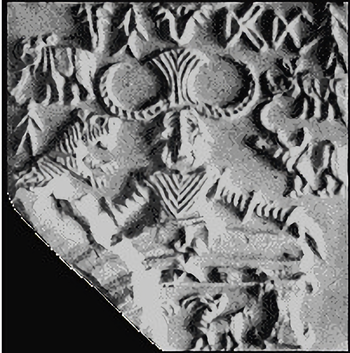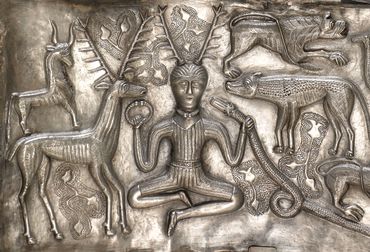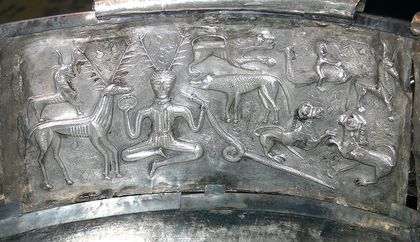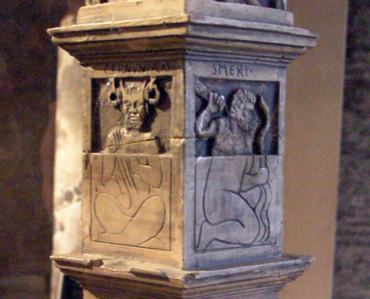「ケルヌンノス」の版間の差分
| 41行目: | 41行目: | ||
ケルヌンノスに関連する図像には、牡鹿と雄羊の角を持つ蛇が描かれていることが多い。あまり多くはないが、牡牛(ランス)、犬、ネズミもいる<ref>https://books.google.com/books?id=VZkTDQAAQBAJ&q=Iconography+of+cernunnos&pg=PT148, Gods of the Celts, Green Miranda, 2011-09-30, The History Press, isbn:9780752468112</ref>。グンデストルップの大釜に描かれた彼の像から、ケルヌンノスを「動物の神」または「野生物の神」と表現する学者もおり、ミランダ・グリーンは彼を「自然と実りの平和な神」<ref>Green, Miranda (1992) ''Animals in Celtic Life and Myth'', p. 228.</ref>と表現し、しばしば動物に囲まれて描かれる伝統的なシャーマンを思わせる形で座っているようだと述べている<ref>Caesar's Druids: story of an ancient priesthood, Aldhouse-Green, Miranda J., Yale University Press, 2010, isbn:9780300165883, location:New Haven, pages86, oclc:808346501</ref><ref group="私注">好戦的な古代のガリア人は「平和の神」など尊ばなかったのではないだろうか。</ref>。 また、チェイサ-・セリス(Ceisiwr Serith)は、ケルヌンノスを双方向性の神、対立するものの間を取り持つ神としており、作品中の動物の象徴はこの考えを反映していると見ている<ref>Fickett-Wilbar, David, 2003, Cernunnos: Looking a Different Way, Proceedings of the Harvard Celtic Colloquium, volume23, pages80–111, issn:1545-0155, jstor:25660728</ref>。 | ケルヌンノスに関連する図像には、牡鹿と雄羊の角を持つ蛇が描かれていることが多い。あまり多くはないが、牡牛(ランス)、犬、ネズミもいる<ref>https://books.google.com/books?id=VZkTDQAAQBAJ&q=Iconography+of+cernunnos&pg=PT148, Gods of the Celts, Green Miranda, 2011-09-30, The History Press, isbn:9780752468112</ref>。グンデストルップの大釜に描かれた彼の像から、ケルヌンノスを「動物の神」または「野生物の神」と表現する学者もおり、ミランダ・グリーンは彼を「自然と実りの平和な神」<ref>Green, Miranda (1992) ''Animals in Celtic Life and Myth'', p. 228.</ref>と表現し、しばしば動物に囲まれて描かれる伝統的なシャーマンを思わせる形で座っているようだと述べている<ref>Caesar's Druids: story of an ancient priesthood, Aldhouse-Green, Miranda J., Yale University Press, 2010, isbn:9780300165883, location:New Haven, pages86, oclc:808346501</ref><ref group="私注">好戦的な古代のガリア人は「平和の神」など尊ばなかったのではないだろうか。</ref>。 また、チェイサ-・セリス(Ceisiwr Serith)は、ケルヌンノスを双方向性の神、対立するものの間を取り持つ神としており、作品中の動物の象徴はこの考えを反映していると見ている<ref>Fickett-Wilbar, David, 2003, Cernunnos: Looking a Different Way, Proceedings of the Harvard Celtic Colloquium, volume23, pages80–111, issn:1545-0155, jstor:25660728</ref>。 | ||
| − | + | 「船乗りの柱」は彼を船員や商業と結びつけており、ランス(フランス、シャンパーニュ地方マルヌ県)のケルヌンノス(古代、レミ族の都市ドロコルトウム(Durocortorum))の硬貨入れやトレヴェリ族の土地ニーデルコルン-トルベルスラッフ(Niedercorn-Turbelslach(ルクセンブルグ))の鹿が吐く硬貨と同様に、彼も物質的豊かさと関連していたことが示唆される。 | |
2022年11月20日 (日) 23:43時点における版
(参照方法、2021年8月) ケルヌンノス(Cernunnos または Kernunnos)は、ケルト神話の狩猟の神にして冥府神。獣王・動物王であったと推定されている。また、多産と豊作に関係があったと考えられている。古代ケルトやガロ・ローマの宗教では、ケルヌンノス(Cernunnos)またはカルノノス(Carnonos)は角を持ち、あぐらをかいて座る姿で描かれた神で、鹿、角のある大蛇、犬、雄牛と関連している。ケルヌンノスは通常、トルクを持つか身につけており、時にはコイン(または穀物)の入った袋とコルヌコピアを持つ姿も見られる[1]。ケルヌンノスは、元々はケルトの神であったと考えられており、ガリア北東部を中心に50以上の描写や碑文が残されている。
目次
概要
ケルヌンノスという名称はパリで出土した「船乗りの柱」に見られる(ただし不完全で、冒頭の1文字が欠けている)。彼の姿は、デンマークで発見され、紀元前1世紀まで遡るとされる銀製のグンデストルップの大釜(Gundestrup Cauldron)にも描かれている。ここでは、彼は胡坐をかいており、頭に二本の角、手には山羊(もしくは雄羊)頭の蛇を持っている。これは角のある神としての一般的な描写である。要出典範囲、地母神を妻としたが、この女神は後に破壊神エススについた、2015年10月。
起源
碑文や絵画、像といった考古学的資料によると、ケルヌンノスはガリア、北イタリア(Gallia Cisalpina)、ブリテンの南の沿岸地方で崇拝されていた。イタリアのヴァル・カモニカ(Val Camonica)で発見されたものが最古の描写と思われ、これは紀元前4世紀のものである。もっとも有名なものはデンマークで見つかったグンデストルップの大釜(Gundestrup Cauldron)で、これは紀元前1世紀のものである。この神の名前はパリの「船乗りの柱」から知られる。この奉献碑は現在パリの国立中世美術館に展示されている。ガリア人の水夫達が1世紀の初めに作ったもので、碑文(CIL XIII number 03026)からみておそらく紀元14年、ティベリウス皇帝の即位の際のものであろう。これが発見されたのは1710年のことで、ノートルダム寺院の基礎からであった。この場所はルテティア(パリの古代ローマ時代の名前)、ケルトのパリシイ族の「市民的な」(civitas)首都であった。そこにはケルヌンノス初め各種ケルトの神々がユーピテル、ウゥルカーヌス、カストル、ポルックスといったローマ神話の神々と並んで描かれている。
この神の名前を書いた出土品としては「船乗りの柱」が最も古いものだが、他にも二つの同様な碑文が見つかっている。一つは Treveri の勢力圏であった Seinsel-Rëlent (ルクセンブルク)で発見された金属の飾り板である。この碑文からは "Deo Ceruninco" (神ケルニンコスに)という文字が読み取れる(AE 1987, 0772)。もう一つは フランスのラングドック=ルシヨン地域圏エロー県にあるモンタニャック(Montagnac)で発見されたゴール(Gaul)の碑文で、ギリシア語で "αλλετ[ει]υος καρνονου αλ[ι]σο[ντ]εας" とカルノノスの名が記されている。
名前と語源
「船乗りの柱」の碑文は [_]ernunnos となっており、いつかの時点で名前の最初の文字が欠落している。しかし、この名前を "Cernunnos" と復元するのに問題点はない。というのは、名前の下に枝角を持った神の絵があるからで、ガリア語の carnon, cernon は「枝角」、「角」を意味している(Delmarre, 1987 pp. 106 - 107)。同様に、古いアイルランド語では cern は「角」、 "bumb, boss" を意味し、ウェールズ語やブレトン語の類似単語 carn とも語源的に関連している。これらは原インド・ヨーロッパ語の *krno- からきたものである。ラテン語の cornu 、ゲルマン語の *hurnaz (英語の "horn" の元)も同じ語源である(Nussbaum 1986; Porkorny 1959 pp.574 - 576)。 Carnutes、Carni、Carnonacae といった部族名、進軍ラッパの carnyx にも同一のガリア語の語源が見いだされる。そこでこの神名素の原ケルト語形は *Kerno-on-os ないし *Karno-on-os と再構成できる。どちらも「角のある男性的な(霊)」という意味である。 -on- という部分は非常に多いわけではないがしばしば神名素に現れる。例えば、マポノス(Map-on-os)、エポナ(Ep-on-a)、マトロナエ(Matr-on-a)、シローナ(Sir-on-a)のように。
受け入れられているケルト語の音韻規則に従えば、この原ケルト神名素の Romano-British 形は *Cernonos か *Carnonos であったと思われる。いずれもガリ語の Cernunnos と極めて似ている(以上、日本語版Wikipedia)。
ガリア語では、Cernunnosの名前の語源は、「角」「鹿の角」を意味するkarnonである。 Karnonはラテン語のcornuやゲルマン語の*hurnazと同族で、最終的にはプロト・インド・ヨーロッパ語の*k̑r̥no-に由来する[2]。大陸ケルト語のガリア人とガラテヤ人の支流には、「角」(karn- "horn")という語源が見られる。アレキサンドリアのヘシキウス(Hesychius)は、ガラテヤ語のkarnon (κάρνον) を「ガリアのラッパ」、つまりテサロニカのエウスタティウス(Eustathius)がcarnix (κάρνυξ) として挙げたケルト軍の角笛を、動物の形の鐘を持つ楽器と解釈している[3]。この語源はケルトの諸集団の名前にも現れ、中でも「角のある者」という意味のCarnutesが有名である[4]。また、碑文に見られるいくつかの人名にも見られる[5]。
プロト・ケルト語のテオニムの形態は、*Carno-on-osとして再構築されている。マポノス、エポナ、マトロエナ、シローナなどのように、増大詞の-on-はテオニムの特徴である[6]。マイヤー(Maier(2010))は、Cernunnosの語源は不明だが、ケルト語の「角」または「鹿の角」(Carnonosと同様)に根ざしていると思われると述べている[7]。
「ケルヌンノス」は、ケルト人によっては、ガリア神話の中でもっとよく知られた神の不明瞭な蔑称であると信じている。おそらく『ローマ語訳(Interpretatio Romana)』にメルクリウスまたはディス・パテルとして記述されている神で[8]、ケルヌンノスの精神文化または神々の関連性を共有していると考えられていた[9]。この名前は一度だけ図像付きで登場し、「船乗りの柱(ガリア人の一族であるパリシイ族の船員による))」に刻まれた。その他、エロー県モンタニャックのギリシャ文字で書かれたケルト語の碑文にも、ケルヌンノスの名前のバリエーションが見られる(καρνονου, karnonou, in dative case)[10]。ガロ・ラテン語の形容詞carnuātus「角のある」も発見されている[11]。
碑文学的証拠
ケルヌンノスに関する神話や、彼が持っていたと思われる様々な蔑称の物語、宗教的実践や信者に関する情報など、ガリア文学が現存していないため、ガリアの宗教的伝統における彼の全体的な意義は不明である。ガリア文化における彼の役割の解釈は、動物、自然、豊穣の神と見なすものから、旅行、商業、双方向性の神と見なすものまで様々である[12]ケルヌンノスの存在の証拠に、さまざまな遺物に刻まれた碑文が残っているのみである。
「船乗りの柱」はは、おそらく紀元14年にガリア人の船乗りたちによって建てられたものである[13]。1710年、ケルト系パリ人の首都であった古代ルテティアの遺跡であるパリのノートルダム大聖堂の基礎の中から発見されたものである。現在、パリの国立モヤーン時代美術館に展示されている[14]。この特徴的な石柱は、ガロ・ローマ時代の宗教の重要な遺跡である。 その低いレリーフには、ユーピテル、ウゥルカーヌス、カストールとポルックスといったローマの神々や、エスス、スメルトリオス、タルボス・トリガラヌスといったガリアの神々が描かれ、名前が記されている。ケルヌンノス(Cernunnos)という名前は、18世紀の碑文の図面からはっきりと読み取ることができるが、その後、頭文字が不明瞭になり、現在では「[_]ernunnos」という読み方しか確認することができない[15]。
さらに、ケルトのトレヴェリ族の領土であるルクセンブルクのシュタインセル・ルーレントの金属板に刻まれた1つの銘文が、ケルヌンノスの存在の根拠となっている。 この碑文[16]には「セルニンコス神に(Deo Ceruninco)」とあり、同じ神であると推測される(要出典, October 2010)。 モンタニャックのガリア語碑文[17]には、「αλλετ[ει]νος καρνονου αλ[ι]σο[ντ]εας (アルレテxノス(Alletinos) [これを捧ぐ] アリソンテア(Alisontea)のカルノノス(Carnonos)) とあり、最後の言葉はおそらく Alisia 「奉仕の木」あるいは「岩」(Alesia、ガリアのAlisiiaと比較)に基づく地名であるだろうと考えられている[17]。
図像

ケルヌンノスの描かれ方はケルト圏を通じ極めて一貫している。もっともわかりやすい特徴は牡鹿の角であり、通常長髪で髭をたくわえた成人男性の姿で、ケルトで高貴のしるしである豪華な装飾を施された首輪、トルクを身に付けている。硬貨で一杯の財布を持つのと同様に、しばしば他のトルクを腕や角にぶら下げているものもある。通常、足を組んで座る姿で描かれ、その姿勢は瞑想しているともシャーマンの呪術を行なう姿ともいわれているが、実際はケルト人が狩猟のときにしゃがむという事実を反映しているに過ぎないのかもしれない。
ケルヌンノスはほとんど常に動物、特に牡鹿と共に描かれる。しばしばこの神特有の動物であり第一の眷属と考えられる牡羊の角をもった蛇と共に描かれるが、蛇自体も神であったかもしれない。また、これらほど頻繁ではないものの牡牛1、犬やドブネズミなどの獣が傍らに描かれることもある。動物と共に描かれることが多いことから、研究者はケルヌンノスを「百獣の神」ないし「野生の神」と呼ぶことがある。特に牡鹿と共に描かれ、これが主要な獲物であったことから「狩猟の神」と呼ばれることもある。興味深いことに「船乗りの柱」はケルヌンノスを水夫や貿易と結びつけるが、古代にはドゥロコルトルムというレミ族の城市だったフランス、シャンパーニュ地方のマルヌ県から出土したケルヌンノスの硬貨入れや、トレウェリ族の居住地内にあったルクセンブルクの Niedercorn-Turbelslach から出土した硬貨を吐き出す鹿などから彼と物質的な豊かさとの関連が伺える。また、この神は森に住む鹿の繁殖力の象徴であったかもしれない。
「船乗りの柱」には、鹿の角を持つ像が描かれており、二つの角にはトルクがぶら下がっていて、ケルヌンノス([C]ernunnos)の銘が一緒に刻まれている。 レリーフの下部は欠けているが、その寸法から、神は伝統的に「仏陀の姿勢(Buddhic posture)」と呼ばれる描写で、あぐらをかいて座っていたと考えられ[18]、グンデストルップの大釜の角のある像と直接的に類似したものとなっている[19]。
ケルヌンノスに関連する図像には、牡鹿と雄羊の角を持つ蛇が描かれていることが多い。あまり多くはないが、牡牛(ランス)、犬、ネズミもいる[20]。グンデストルップの大釜に描かれた彼の像から、ケルヌンノスを「動物の神」または「野生物の神」と表現する学者もおり、ミランダ・グリーンは彼を「自然と実りの平和な神」[21]と表現し、しばしば動物に囲まれて描かれる伝統的なシャーマンを思わせる形で座っているようだと述べている[22][私注 1]。 また、チェイサ-・セリス(Ceisiwr Serith)は、ケルヌンノスを双方向性の神、対立するものの間を取り持つ神としており、作品中の動物の象徴はこの考えを反映していると見ている[23]。
「船乗りの柱」は彼を船員や商業と結びつけており、ランス(フランス、シャンパーニュ地方マルヌ県)のケルヌンノス(古代、レミ族の都市ドロコルトウム(Durocortorum))の硬貨入れやトレヴェリ族の土地ニーデルコルン-トルベルスラッフ(Niedercorn-Turbelslach(ルクセンブルグ))の鹿が吐く硬貨と同様に、彼も物質的豊かさと関連していたことが示唆される。
The Pilier des nautes links him with sailors and with commerce, suggesting that he was also associated with material wealth as does the coin pouch from the Cernunnos of Rheims (Marne, Champagne, France)—in antiquity, Durocortorum, the civitas capital of the Remi tribe—and the stag vomiting coins from Niedercorn-Turbelslach (Luxembourg) in the lands of the Treveri. The god may have symbolized the fecundity of the stag-inhabited forest.
Other examples of Cernunnos imagery include a petroglyph in Val Camonica in Cisalpine Gaul.[9][24] The antlered human figure has been dated as early as the 7th century BCE or as late as the 4th.[24] Two goddesses with antlers appear at Besançon and Clermont-Ferrand, France. An antlered god appears on a relief in Cirencester, Britain dated to Roman times and appears depicted on a coin from Petersfield, Hampshire.[9] An antlered child appears on a relief from Vendeuvres, flanked by serpents and holding a purse and a torc.[25] The best known image appears on the Gundestrup cauldron found on Jutland, dating to the 1st century BCE, thought to depict Celtic subject matter though usually regarded as of Thracian workmanship.
Among the Celtiberians, horned or antlered figures of the Cernunnos type include a "Janus-like" god from Candelario (Salamanca) with two faces and two small horns; a horned god from the hills of Ríotinto (Huelva); and a possible representation of the deity Vestius Aloniecus near his altars in Lourizán (Pontevedra). The horns are taken to represent "aggressive power, genetic vigor and fecundity."[26]
Divine representations of the Cernunnos type are exceptions to the often-expressed view that the Celts only began to picture their gods in human form after the Roman conquest of Gaul.[27] The Celtic "horned god", while well attested in iconography, cannot be identified in description of Celtic religion in Roman ethnography and does not appear to have been given any interpretatio romana, perhaps due to being too distinctive to be translatable into the Roman pantheon.[28] While Cernunnos was never assimilated, scholars have sometimes compared him functionally to Greek and Roman divine figures such as Mercury,[29] Actaeon, specialized forms of Jupiter, and Dis Pater, the latter of whom Julius Caesar said was considered the ancestor of the Gauls.[30]
Possible reflexes in Insular Celtic
There have been attempts to find the cern root in the name of Conall Cernach, the foster brother of the Irish hero Cuchulainn[31] in the Ulster Cycle. In this line of interpretation, Cernach is taken as an epithet with a wide semantic field—"angular; victorious; prominent," though there is little evidence that the figures of Conall and Cernunnos are related.[32]
A brief passage involving Conall in an eighth-century story entitled Táin Bó Fraích ("The Cattle Raid on Fraech") has been taken as evidence that Conall bore attributes of a "master of beasts."[8] In this passage Conall Cernach is portrayed as a hero and mighty warrior who assists the protagonist Fraech in rescuing his wife and son, and reclaiming his cattle. The fort that Conall must penetrate is guarded by a mighty serpent. The supposed anti-climax of this tale is when the fearsome serpent, instead of attacking Conall, darts to Conall's waist and girdles him as a belt. Rather than killing the serpent, Conall allows it to live, and then proceeds to attack and rob the fort of its great treasures the serpent previously protected.
The figure of Conall Cernach is not associated with animals or forestry elsewhere; and the epithet "Cernach" has historically been explained as a description of Conall's impenetrable "horn-like" skin which protected him from injury.
Possible connection to Saint Ciarán
Some see the qualities of Cernunnos subsumed into the life of Saint Ciarán of Saighir, one of the Twelve Apostles of Ireland. When he was building his first tiny cell, as his hagiography goes, his first disciple and monk was a boar that had been rendered gentle by God. This was followed by a fox, a badger, a wolf and a stag.[34]
Neopaganism and Wicca
Within Neopaganism, specifically the Wiccan tradition, The Horned God is a deity that is believed to be the consort of the Great Goddess and syncretizes various horned or antlered gods from various cultures. The name Cernunnos became associated with the Wiccan Horned God through the adoption of the writings of Margaret Murray, an Egyptologist and folklorist of the early 20th century. Murray, through her Witch-cult hypothesis, believed that the various horned deities found in Europe were expressions of a "proto-horned god" and in 1931 published her theory in "The God of the Witches". Her work was considered highly controversial at the time, but was adopted by Gerald Gardner in his development of the religious movement of Wicca.[35]
Within the Wiccan tradition, The Horned God reflects the seasons of the year in an annual cycle of life, death and rebirth and his imagery is a blend of the Gaulish god Cernunnos, the Greek god Pan, The Green Man motif, and various other horned spirit imagery.[36][37]
In popular culture
- Cernunnos is featured in both Marvel Comics and DC Comics as a member of the Celtic pantheon.
- Cernunnos is a playable hunter as the second of the Celtic gods to arrive in Smite.
- In the french production Black Spot Cernunnos is referred to frequently as the woodsman.
See also
- Abbots Bromley Horn Dance
- Celtic polytheism
- Celtic Reconstructionist Paganism
- Green Man
- Herne the Hunter
- Horned God
References
- Corpus Inscriptionum Latinarum (CIL) volume 13, number 03026
- Delmarre, Xavier (2003). Dictionnaire de la langue gauloise (2nd ed.). Paris: Editions Errance. ISBN 2-87772-237-6.
- Lejeune, Michel (1995). Recueil des inscriptions gauloises (RIG) volume 1, Textes gallo-grecs. Paris: Editions du CNRS.
- Nussbaum, Alan J. (1986). Head and Horn in Indo-European. Berlin, New York: Walter de Gruyter. ISBN 3-11-010449-0.
- Porkorny, Julius (1959). Indogermanisches etymologisches Wörterbuch. Berlin: Franke Verlag.
External links
- "Is the Gundestrup Cauldron an Authentic Celtic Artifact?": A possibly ancient depiction of the Horned God
中世の痕跡
この神の痕跡はキリスト教時代にまでたどることができる。ウェールズとアイルランド双方の文学的伝統の中で、この神を仄めかす記述を見つけることができる。ブリタニーでは伝説の聖者、カルナック(Carnac)のコーネリ(Korneli または Cornély)にケルヌンノスの属性がある。イギリスの民間伝承にみられる狩人ハーン(Herne the Hunter)もケルヌンノスの暗示であると示唆する説もあるが、ハーンはウィリアム・シェイクスピアの劇『ウインザーの陽気な女房達』第4幕第4場で初めて言及されるサクソン人の生き残りであることから、この説は疑わしい。
復興異教主義
ウイッカに代表される現代の復興異教主義運動(Neopaganism)では、角のある神に対する崇拝が復活した。信奉者はケルヌンノス一般的に生命と豊穣と死のサイクルを追っている。この神の死は現在、通常サウィン、すなわち10月31日に行われるケルトの新年の祭の日に設定されている。
歴史的なケルヌンノスと復興異教主義のそれとの大きな違いは、後者が男根的象徴の傾向を持っていることである(ただし、この特徴はヴァル・カモニカの図像に見られる)。パンとの混淆や、 サバトの悪魔レオナール等の描写から来ているのだろう。
参考文献
- Wikipedia:ケルヌンノス(最終閲覧日:22-11-12)
- Corpus Inscriptionum Latinarum (CIL) volume 13, number 03026
- Delmarre, Xavier (2003) Dictionnarie de la langue gauloise (2nd ed.) Paris: Editions Errance. ISBN 2-87772-237-6
- Lejeune, Michel (1995) Receuil des Inscriptions Gauloise (RIG) volume 1, Textes gallo-grecs. Paris: Editions du CNRS
- Nussbaum, Alan J. (1986) Head and Horn in Indo-European, Berlin, New York: Walter de Gruyter. ISBN 3110104490
- Porkorny, Julius (1959) Indogermanisches etymologisches Wörterbuch Berlin: Franke Verlag
関連項目
外部リンク
私的注釈
- ↑ 好戦的な古代のガリア人は「平和の神」など尊ばなかったのではないだろうか。
参照
- ↑ Green, Miranda, Celtic Art, Reading the Messages, p. 147, 1996, The Everyman Art Library, ISBN:0-297-83365-0
- ↑ Pokorny (1959) "k̑er-, k̑erə-; k̑rā-, k̑erei-, k̑ereu"[1], https://web.archive.org/web/20140307155522/http://www.utexas.edu/cola/centers/lrc/ielex/X/P0929.html, 2014-03-07
- ↑ Delamarre; Greek text and English translation of the passage from Eustathius' Homeric commentaries given by Edward Wigan, "Account of a Collection of Roman Gold Coins", Numismatic Chronicle 5 (1865), p. 11 online.
- ↑ Also Carni and Carnonacae.
- ↑ Such as Carnarus, Carnatus, Carneolus, Carnius, and Carnicus. Altay Coşkun and Jürgen Zeidler, "'Cover Names' and Nomenclature in Late Roman Gaul: The Evidence of the Bordelaise Poet Ausonius" (2003), p. 33.
- ↑ Delamarre, citing M. Lejeune, Lepontica (Paris 1971), p. 325.
- ↑ Bernard Maier, Dictionary of Celtic Religion and Culture (Alfred Kröner, 1994; Boydell, 2000), p. 69.
- ↑ 8.0 8.1 Anne Ross. (1967, 1996). Pagan Celtic Britain: Studies in Iconography and Tradition. Academy Chicago Publishers.
- ↑ 9.0 9.1 9.2 Celtic Culture: A Historical Encyclopedia, Breviary A., Kock John T., ABC-CLIO, volume1, 2005, Celticism, pages396, isbn:978-1851094400, id:f899xH_quaMC, page=396
- ↑ Xavier Delamarre, Dictionnaire de la langue gauloise (Éditions Errance, 2003), pp. 106–107.
- ↑ Equivalent to Latin cornutus, "horned"; Delamarre, citing J. Vendryes, Revue Celtique 42 (1925) 221–222.
- ↑ Green Miranda, Animals in Celtic Life and Myth, pages227–8, 1992, Routledge, https://ceisiwrserith.com/therest/Cernunnos/cernunnospaper.htm
- ↑ Based on the inscription (CIL XIII. 03026), on the accession of the Roman emperors|emperor Tiberius.
- ↑ A. Kingsley Porter, "A Sculpture at Tandragee," Burlington Magazine 65 (1934), p. 227, pointing out the relative maturation of the antlers.
- ↑ Phyllis Fray Bober, Cernunnos: Origin and Transformation of a Celtic Divinity, American Journal of Archaeology, Vol. 55, No. 1 (Jan., 1951), pp. 13-51, https://www.jstor.org/stable/501179
- ↑ AE 1987, 0772 = AE 1989, 00542.
- ↑ Delamarre, Dictionnaire pp. 38–39. See also Pierre-Yves Lambert, La langue gauloise (Éditions Errance, 2003), pp. 53 and 58.
- ↑ Blázquez Martínez, J. M. (1957). Una réplica desconocida al Cernunnos de Val Camonica: el Cernunnos de Numancia. Revue d'Études Ligures, 23, fasc. 3-4, 1957, pp. 294-298.
- ↑ https://books.google.com/books?id=m8-IAgAAQBAJ&q=Iconography+of+cernunnos+Gundestrup+cauldron&pg=PA89, Symbol and Image in Celtic Religious Art, Green Miranda, 2003-10-03, Routledge, isbn:9781134893942
- ↑ https://books.google.com/books?id=VZkTDQAAQBAJ&q=Iconography+of+cernunnos&pg=PT148, Gods of the Celts, Green Miranda, 2011-09-30, The History Press, isbn:9780752468112
- ↑ Green, Miranda (1992) Animals in Celtic Life and Myth, p. 228.
- ↑ Caesar's Druids: story of an ancient priesthood, Aldhouse-Green, Miranda J., Yale University Press, 2010, isbn:9780300165883, location:New Haven, pages86, oclc:808346501
- ↑ Fickett-Wilbar, David, 2003, Cernunnos: Looking a Different Way, Proceedings of the Harvard Celtic Colloquium, volume23, pages80–111, issn:1545-0155, jstor:25660728
- ↑ 24.0 24.1 Webster, "Creolizing the Roman Provinces," p. 221, especially note 103.
- ↑ Anne Ross, "Chain Symbolism in Pagan Celtic Religion," Speculum 34 (1959), p. 42.
- ↑ Francisco Marco Simón, "Religion and Religious Practices of the Ancient Celts of the Iberian Peninsula," e-Keltoi: Journal of Interdisciplinary Celtic Studies 6 (2005), p. 310.
- ↑ Webster, "Creolizing the Roman Provinces," p. 221.
- ↑ Jane Webster, "Creolizing the Roman Provinces," American Journal of Archaeology 105 (2001), p. 222; distinctiveness of Cernunnos also in William Van Andringa, "Religions and the Integration of Cities in the Empire in the Second Century AD: The Creation of a Common Religious Language," in A Companion to Roman Religion (Blackwell, 2007), pp. 87–88.
- ↑ David M. Robinson and Elizabeth Pierce Belgen, "Archaeological Notes and Discussions," American Journal of Archaeology 41 (1937), p. 132.
- ↑ Phyllis Fray Bober, "Cernunnos: Origin and Transformation of a Celtic Divinity," American Journal of Archaeology 55 (1951), p. 15ff.
- ↑ Porter, A Sculpture at Tandragee, p. 227.
- ↑ John Koch. (2006) Cernunnos [in] Celtic Culture: A Historical Encyclopedia, p. 396. ABC-Clio.
- ↑ Umberto Sansoni-Silvana Gavaldo, L'arte rupestre del Pià d'Ort: la vicenda di un santuario preistorico alpino, p. 156; Ausilio Priuli, Piancogno su "Itinera".{{{date}}} - via {{{via}}}..
- ↑ テンプレート:Cite book
- ↑ Forced into the Fringe: Margaret Murray's Witch-Cult Hypothesis.21 April 2017 - via {{{via}}}.
- ↑ Farrar, Stewart & Janet, Eight Sabbats for Witches
- ↑ The Rebirth of Witchcraft, Doreen Valiente, page 52-53


